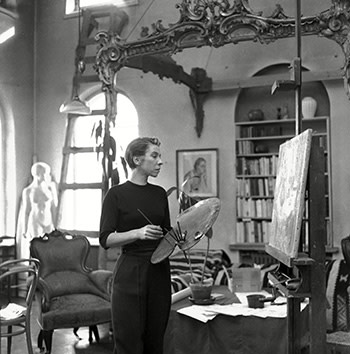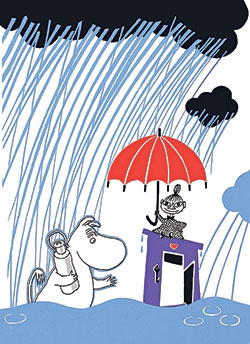Life, Art, Words, by Boel Westin; Sculptor’s Daughter, by Tove Jansson
Simply sign up to the Life & Arts myFT Digest -- delivered directly to your inbox.
Tove Jansson: Life, Art, Words, by Boel Westin, translated by Silvester Mazzarella, Sort of Books, RRP£25, 528 pages
Sculptor’s Daughter, by Tove Jansson, translated by Kingsley Hart, Sort of Books, RRP£9.99, 192 pages

In autumn 1945, as an exhausted Europe emerged from almost six years of war, young Finns and Swedes were introduced to a family they would come to know very well. Tove Jansson’s first book, The Moomins and the Great Flood, follows Moominmamma and her son Moomintroll in their search for Moominpappa, who is lost, feared dead. They travel through a dark forest, drawn beautifully by Jansson in pen and tinted wash, using a primitivist style reminiscent of Henri Rousseau. Near the end of their quest, the weather turns strange: “It had become very hot late in the afternoon. Everywhere the plants drooped, and the sun shone down with a creepy red light.” This presages a rainstorm so powerful that the land is submerged. Moominpappa is eventually discovered alive and well, perched high above the waters in the branches of a tree.
The Great Flood was not a commercial success and attracted little attention – which perhaps explains why it was the last of the Moomin books to be translated into English, in 2005. It was only when the third volume in the series, Finn Family Moomintroll, came out three years later in 1948 that the Moomins begin their ascent to international fame. By the 1960s Jansson’s creation was manifesting as TV cartoons, stage plays and a bewildering range of licensed merchandise. There were picture books and also a widely syndicated newspaper strip, which Jansson wrote and drew herself before handing over responsibility to her younger brother Lars.
The Moomins remain big business. All the books are in print and sell healthily. The Finnish city of Turku boasts a theme park, Moomin World, where you can visit the characters’ houses and have your photograph taken with actors in costume. There is even a shop in London’s Covent Garden peddling nothing but what one might call “Moominery”.
The stories have also exerted an influence on many modern writers, for adults as well as children. Ali Smith, Jeanette Winterson and Maggie O’Farrell are self-professed Moomin fans. Philip Pullman has called Jansson a “genius”, while Frank Cottrell Boyce drew important life lessons from the Moomins at an impressionable age. “Jansson valorised coffee and pancakes and reticence and the mystery of others,” he wrote in a review of Moomin picture book The Dangerous Journey. “But more to the point she showed me how it might be just those small pleasures that keep us together when we start to grow apart.”
The young Boyce, however, was also drawn to the Moomins because he sensed an existential darkness at the heart of the books. Jansson wrote in the dominant mode of 20th-century children’s literature, fantasy, but hers was fantasy shot through with a quiet anguish. Apocalypse through natural disaster – flood, volcano, potentially earth-shattering comet – looms in the background of her stories. Characters are solitary, lonely, sometimes on the brink of despair, and acknowledge the fragility of things with an accommodating liberal shrug.
Boel Westin’s biography of the author, Tove Jansson: Life, Art, Words, arrives in English translation in time for the centenary of its subject’s birth (the Swedish edition came out in 2007, the Finnish in 2008). Westin is at pains to show that, although the Moomins are Jansson’s lasting legacy and a significant body of work in their own right, there was more to her. The book gives equal weight to her achievements as a painter, cartoonist, muralist, memoirist and writer of fiction for adults.
Jansson grew up in Helsinki, the eldest of three children. Her parents, Finnish sculptor Viktor Jansson and Swedish illustrator Signe Hammarsten, maintained a bohemian household in which love and art were valued above all else, but the family’s existence was financially precarious. By her mid-teens young Tove was already helping top up the Jansson coffers by providing illustrations and comic strips for children’s periodicals. Studying fine art in Stockholm, Helsinki and Paris, she saw her future as a painter, with commercial illustration an income-generating sideline. During the war she contributed frequently to the magazine Garm, including several cartoons lampooning Hitler and Stalin. Soon she had begun accompanying her signature on the pictures with a drawing of a cute little hippopotamus-like creature with big guileless eyes, which she called a “Snork” – the prototype for Moomintroll.
Once the Moomin bandwagon began rolling in earnest, Jansson – almost to her own surprise – proved to be a shrewd businesswoman. She personally supervised contracts for merchandising spin-offs and berated licensees when their product failed to meet her exacting standards. On one occasion, she lambasted the makers of a Japanese animated series that depicted the Moomins (normally plain white) in various colours and featured them boozing and carousing, something they never did in the books. She also nixed, on grounds of good taste, a proposal from a tampon company to manufacture sanitary towels for young girls printed with the image of the Moomins’ adopted daughter Little My.

Although Jansson had had affairs with men and nearly married a leftwing intellectual called Atos Wirtanen, it was with a graphic artist called Tuulikki Pietilä that she found contentment. From the 1950s the two women lived together, travelled extensively and collaborated professionally. Jansson’s lesbianism upset her mother but, by Westin’s account, seems not to have scandalised Scandinavia or raised any eyebrows in the wider world.
Westin shows how the Moomin phenomenon became a millstone for Jansson. As the cash and contracts kept rolling in, the author found herself longing increasingly for space and solitude, the freedom to work uninterrupted by business demands and by the promotional duties that were stressful to someone so solitary and self-contained. She built a house on a tiny, remote island in the Gulf of Finland but still Moomin aficionados trooped to her front door and begged her time. She dutifully, if grudgingly, replied to fan mail, which came in by the sackful. Her mother had drilled into her the importance of not leaving correspondence unanswered.
After the ninth and final Moomin book, Moominvalley in November (1971), Jansson concentrated on writing for adults, mostly in the form of short stories. By then, the Moomins had in any case become victims of their own success, at least as far as the critics were concerned. Reviews of the later books found the stories and settings too cosy, too conservative. “Ideology and class were more important on the agenda of the age,” Westin writes, “and the Moomins’ superficially gender-determined way of life was an easy target in the socially aware 1960s.”
Here we come to a problem with Tove Jansson: Life, Art, Words, namely that Westin is a professor of comparative literature at Stockholm University, specialising in children’s fiction, and her own criticism of the texts carries a deadening whiff of academe. When discussing Jansson’s picture book Who Will Comfort Toffle? (1960), for example, Westin says: “The story is in fact constructed from holes, openings and grottoes combined with phallus-shaped environments and objects [ . . . ] The oblong milk can links mother and child (though the milk goes sour) and is transformed into a symbol of incipient (male) independence.” Yes, or it could just be a charming, inventive little fable for toddlers.
Parts of the book read like a doctoral thesis, and at times the tone seems to straitjacket its subject matter. We get precious little sense of the whimsicality that’s to be found in the Moomin stories, nor the underlying sombreness. Westin could afford to lighten her analysis, to relax and let her evident love for all things Moomin shine through.
That said, her biography – translated smoothly and unobtrusively by Silvester Mazzarella – is never less than engaging. It is also copiously illustrated with photos and reproductions of Jansson’s artwork, which is appropriate for a book about a woman for whom word and image were of equal significance and who did her utmost to find a harmonious balance between the two in her creative output.
Jansson, a habitual self-portraitist, left several prose snapshots of her life in the form of novels and short-story collections that are so autobiographical they may as well be called memoir. One actual memoir, Sculptor’s Daughter, first published in 1968, has recently been reprinted, and it’s an unusual, haunting re-creation of Jansson’s childhood, told impressionistically as a series of discrete episodes.
“The Bays”, for instance, is a tour of five deserted rocky inlets that Jansson loved to explore in her youth. It opens with the line: “The house is grey, the sky and sea are grey, and the field is grey with dew.” The girl in the story is herself “light grey”, almost invisibly a part of the landscape. It is an affecting evocation of a pure, unquestioning relationship with nature, the kind that we can only really have as children.
Elsewhere there are glimpses of life in the freewheeling Jansson family household, where mishaps are greeted with a phlegmatic, Moomin-like acceptance. When the narrator’s father’s pet monkey knocks over a couple of his works-in-progress in the studio, ruining them, he speaks consolingly to it. When the narrator hides under the Christmas tree and accidentally breaks one of the baubles, her mother says, “Actually that ball has always been the wrong colour.” Similarly, when Moominpappa drops a vegetable dish on the floor in Comet In Moominland, (1946), Moominmamma calmly says, “Never mind. It’s really a good thing it’s broken – it was so ugly.”
Sculptor’s Daughter tells us as much about Jansson’s formative years and the genesis of her most famous creation as any biography could, in succinct, dreamlike prose shot through with striking images and turns of phrase. Its themes are the consolations of home, the certainties of family relationships, the contentments of childhood – the same things that have kept the Moomins forging stoically on.
James Lovegrove is the FT’s children’s book critic
Comments